



[Edited & Annotated Transcript]
Will On-line Shopping Impact Retail Leasing?
By Mark Borsuk1
Managing Director
The Real Estate Transformation Group:
property strategies for the information agesm
Presented to
Electronic Retailing Panel
ICSC-Southern California Idea Exchange
Anaheim Marriott, Anaheim, CA
February 21, 1997
Copyright © 1997. All Rights Reserved. Mark Borsuk.
Don’t Be a Cyberputz.
In 1906, my grandfather came to California and when I was growing up he always told me
three things:
1. The old country was filthy;
2. Get a trade; and
3. Don't be a Cyberputz.
I became a lawyer and in 1994 I understood his admonition. What I discovered was that
INFOTECH was beginning to sever place from activity.
What is INFOTECH? It is the integration of computer hardware, software and
telecommunications into everyday life. In other words, work no longer needs a workplace
and shopping no longer needs a shop.
Information Technology Does Matter.
Today, I would like to talk about how INFOTECH potentially impacts the demand for retail
space. INFOTECH is going to have three major consequences for us.[Chart 1]
1. In three to five years, retailers will begin to reconsider their store-based shopping
model because it reflects a geocentric pattern that consumers have learned since the end
of the Second World War. That is getting in the car to go shopping. The geocentric model
is challenged by INFOTECH.
2. In three to five years, retailers will begin to compare on-line shopping with the cost
of maintaining store and catalog operations.
3. Today, retail landlords can begin to think about the consequences of this, plan for it
and begin to select tenants that are less susceptible to on-line shopping’s
influence.
Technology Induces Change.
To reiterate, INFOTECH severs place from activity; and that is critical to our
understanding of how it impacts real estate. If it severs place from activity, then the
landlord's location premium, the mantra that we all know "location, location,
location" is deprecated because location becomes less important. Conversely, it
shifts the power to the tenants who want to locate physically; it allows them to take a
tougher position in setting rents and negotiating lease terms, because location is no
longer the exclusive attribute of the landlord's value.
[Chart 2]
We have an historical parallel for this. Around 1915, the automobile overtook the horse as
the primary means of transportation in this country. While the need for transportation
continued, the mode of transportation changed. Similarly, I would submit to you that
shopping will continue; however, the mode or more specifically the venue will shift, and
there's the potential harm to retail landlords.
Reformatting the Retail Sales Channel. If INFOTECH favors on-line selling, what
will retailers do? What I suspect is going to happen is the retail sales channel will be
reformatted. [Chart 3] And what I mean by that is
retailers will understand the demographics or what we should call the
"technographics" of the on-line market2, how large it is, how fast it is expanding, the sophistication of
the users, and what goods and services work on-line.
The retailers’ response will be to have a presence on the WEB, go through the
"Three Cs of CyberRetailing", discussed infra, and then to reconsider their need
for shopping center, mall and store space.
The On-line Market.
Let's talk about the technographics of the WEB right now. We can describe "out
there" as Cyberspace. Cyberspace is simply what's on the other side of that computer
screen. In 1996, approximately 35 million households had personal computers. Of those,
about 22 million had modems, so they had the ability to get into Cyberspace and of those,
15 million households were connected on-line. The best estimate today of on-line
households at the end of the decade is about 36 million. The number of on-line households
will more than double in three short years. That translates roughly to one- third of all
U.S. households and we know they are the higher income households.3 This is a very compelling statistic and an
attractive market for retailers. [Chart 4]
On-line Shopping Will Become a New Shopping Habit.
One thing about going on-line, if you've never been there: it is somewhat intimidating-
I'm teaching my father now. Who is going to teach the consumers this new shopping pattern?
What the on-line world does is to resocialize our shopping patterns. For example, the ICSC
is teaching consumers how to shop on-line. And that may seem counter-intuitive, but when I
pulled up this meeting on the ICSC WEB site, I registered and could have paid for it with
my credit card. Well, if you can do this, shopping is a natural. You give the merchant,
who is using a secured site, your home address and your credit card number to execute the
transaction. So the ICSC is teaching the consumer how to shop. The banks, the brokerage
firms, the hotels, the car rental agencies, anything that you can book or transact with
are teaching consumers to shop on-line. It should be noted even given all this
non-retailer activity, the traditional retailers are lagging behind in implementing the
third sales channel.4
Finally, a word about what will likely be a massive, and I repeat massive, PR campaign at
the end of this year by VISA and MasterCard, when they implement the SET protocol. The SET
protocol is the secured electronic transaction protocol that legitimizes shopping on-line
with your credit cards. These organizations will be reassuring consumers that it is safe
and secure to use their credit cards on the Net.
What Goods and Services Work in Cyberspace?
When we talk about what is going to work on-line from the retailer's perspective, I would
suggest to you that perhaps, of the universe of goods and services, maybe one-third work
today with the existing technology, and I would paint a mental picture for you of a
continuum. On one side of the continuum is toilet paper, Heinz catsup and HP laser
printers. In other words, commodity goods that primarily sell on price. There is very
little value added by the retailer. At the other end of that continuum is the chinchilla
fur coat. That means the touch and feel, the kinetics, the esthetics to making a judgment
about an item cannot be conveyed on-line. So, within this continuum, we can begin to think
about how the retailers will analyze the situation and in turn how that will impact
specific retailers.
Another way to look at it is to say, wait a minute, most things we buy today are self-
service. There is no sales person there offering guidance or opinion about what works and
what doesn't work. So, anything that is sold self-service, I would submit to you, has the
possibility of being sold in Cyberspace.
Retailer Response to Cyberspace.
Another aspect of on-line shopping’s impact is the retailers’ response because
those are the people you need if you are a landlord's broker. Tenant reps also must
consider the impact of the on-line venue when evaluating new store locations.
The first retailer response will be to establish a presence on-line. The competitive
nature of retailing compels them to open this third sales channel. On-line retailing is a
hot topic at the National Retail Federation. Discount Store News is having their third
on-line retailing conference. Well, again, these conferences are making the retailers
comfortable with this concept, giving them some insight into how you market on-line and
the benefits.
The Three Cs of CyberRetailing.
To be a player, retailers will have to master the Three Cs of CyberRetailing.[Chart 5]
One to One Marketing.
The first "C" is Connectivity. This is a very, very interesting issue
because the Internet allows one-to-one marketing. For example, I bought an item from Hello
Direct.5 I pulled up their
page, looked for the item, selected it, and paid. Next, I printed my receipt to have
physical proof of purchase. They in turn emailed me back and said, "Yes, we've
received your order and here's the shipping date." That means, they have a record.
Thus, they start to know my purchase pattern. Next time something comes up in that
universe, they may email me and say, "Oh, by the way, we're having a special."
They can tailor their marketing to the individual consumer. That's one tremendous
incentive for retailers to move on-line.
A second aspect of connectivity is scalability. This is more technical, but it has to do
with how fast the on-line shopping market can grow. It's one thing to decide you are going
to roll out a hundred new stores, but that takes, if you are very lucky, a year or two. If
it is scalable, you can do that with technology in a very short period of time. In other
words, if the computer system has the capacity, the scalability, it can easily handle not
a hundred thousand transactions a day, but a million, and then go from a million to ten
million transactions. AOL’s current service problem with busy signals is an example
of being unable to scale up fast enough to deal with the call overload. So connectivity is
the first C in CyberRetailing.
Stealth Competitors.
The second "C" is Competition. Retailers are increasingly concerned with
market share and are beginning to fear the emergence of stealth competitors. [Chart 6] An example of what I am talking about is Amazon
Books. Amazon Books can challenge Barnes & Noble, Crown Books and Borders, but they
don't have any stores. The lack of real estate, store employees and additional overhead
costs gives Amazon a competitive advantage.6 Thus, the growth of on-line book buying works against traditional
competitors with dissimilar cost structures.
So, effectively what happens from the consumers standpoint is that one morning they see an
announcement on-line saying, "We've just opened for business. Please come and visit
our Web site." That's stealth and that is what will increasingly happen to many, many
types of retailers. Their counter-strategy must be to implement on-line transactions to
thwart stealth competitors from skimming their sales.
Real Estate Implications.
The third "C" is Cost. There is a great advantage to being on-line: you
can lower your personnel cost (you don't need as many people); you can streamline your
distribution because less inventory will be necessary as many retailers move to a showroom
format; and finally, that calls into question occupancy costs. How much space are
retailers going to need and where are they going to take it?
The 3rd Transformation in Space Use.
The real estate implications of INFOTECH and the changes taking place based on the
Internet revolution are going to play themselves out in our business-real estate. What I
mean is, that retail is the third iteration of what has been taking place in the
commercial real estate market over the last ten years.7 [Chart 7] Over the last decade,
the re- engineering of corporate America, the Fortune 500, has taken place by realigning
space demand with corporate strategic goals. The re-engineering of the financial system,
especially branch banking is ongoing, and a similar shift in space demand will hit retail.
You can be much more efficient with information technology and you need less space.
What's happened in the last ten years in the corporate world? Well, as I mentioned, re-
engineering and downsizing. The senior management of the large corporations, both
industrial and service, now understand that they can do with less space, the space they
have they need to align with their corporate goals, and that is all within the
over-arching imperative of increasing shareholder value. O.K., that's the corporate world.
The banks are going through the same type of analysis and, in fact, you can now bank
on-line. Wells Fargo just reported that it cost a $1.07 to do a transaction at a teller
window but only $0.01 to do the same transaction over the Internet. 8 This is a very, very
compelling reason to completely rethink their business model, and to re-examine their
branch banking network, their personnel and their overhead cost structure.
The retailers, especially the Chief Financial Officers (CFO) and strategists are going to
react to this trend. They see it in the corporate world; they see it in the financial
world; they are going to understand that a body of heuristics and metrics are available to
reduce space demand. [Chart 8] The strategy is also
being promoted by the big consulting firms. For example, Deloitte & Touche issued a
report last year examining the implications of on-line retailing,9 and I would like to quote to
you what they said:
"...a retailer that has built up an advantage through superior store location and low
cost leases will find this advantage is irrelevant, to the world of CIBER
(Computer/Interactive-Based Electronic Retailing)."
Well, if the CFOs are thinking about the new use of space and the consultants are hustling
the strategy--what do you think is going to happen?
The Sales Migration Dilemma.
The critical issue facing retailers is estimating how much of in-store sales will migrate
to cyberspace? In other words, when does a profitable store become an unprofitable one,
i.e., what percentage of gross sales have to migrate? That is what the number crunchers
must figure out. For example, if it only took a 12% shift in sales to make a store
unprofitable, that has serious implications about what retailers want to do with their
stores, their future expansion plans and leasing.10
Rethinking the Retail Lease.
The lease is the document, the glue, that holds us all together. It binds the landlord and
the tenant. I would submit to you that INFOTECH, will have an influence on how tenants
think about leases, leasing practices, and lease clauses.
The first issue is going to be rent, and here's a possible scenario. It strikes me that
retailers who are looking at this disintermediation and reintermediation phenomenon and
who are analyzing the possibilities of the third sales channel are going to say to
landlords: "We understand your situation, but we would like to convert our fixed rent
obligation to a variable rent obligation. We'll pay you a percentage of gross in-store
sales, because we need more flexibility in order for us to meet our strategic goals."
Now, that change would be so dramatic and so disruptive, it's almost impossible to
contemplate. But, I suggest to you that some smart Ph.D. in finance is doing the analysis
right now. They are saying to themselves "Gee, if we could just convert the rent from
a fixed obligation to a variable cost wouldn’t that improve our income statement and
balance sheet." Landlords will also need to consider how on-line shopping may lessen
their percentage rent.11
O.K., that's the first major impact; and, of course, it plays out in financing projects,
investment analysis and a host of other areas.
The next issue landlords face is the lease term becoming a series of short-term
commitments. Lease terms are shorter than they were ten years ago in many instances, but I
suspect to complement the on-line sales channel lease terms are going to get even shorter,
with multiple short-term options.
Another issue is exit strategies. Most of us know exit strategies in the context of
Chapter 11 filings, but there are other types of exit strategies and I suspect they will
be bargained for very, very hard as the retailers meld the on-line sales venue into their
overall strategy.
In summary, a CyberSales channel is emerging to challenge location-based shopping
patterns. This in turn will have serious implications for retail landlords, both as to
existing tenants and selecting future tenants.
Landlord’s Response to On-line Shopping.
If we know that the retailers are thinking about implementing the third sales channel what
is the retail landlord’s response? In thinking about the response we also must
recognize that it be a slow phase-in because the earliest it will begin to manifest itself
will be in three to five years. However, during the interim we can expect the major retail
associations and successful retailers to begin implementing systems to facilitate on-line
shopping and the business press to frequently report on their successes.
For Landlords, Who Are the New Retail Winners?
If we as landlords know what is coming, what is the appropriate response? In addition to
the traditional financial risk evaluation, we must avoid choosing retailers who will soon
have an incentive to develop the on-line venue at the expense of stores.
The INFOTECH Tenant Screen.
The new winners for landlords will be those tenants whose goods and services will not
easily transfer to Cyberspace, who add a high value added component to the goods and
services they provide customers in their stores, and those tenants who provide unique
service. I would suggest four questions to ask when beginning to evaluate tenants:
1. Who are the tenant's customers?
2. Will they buy in Cyberspace?
This requires us to forget essentially about demographics because those are industrial age
ideas reflecting a geocentric bias. In addition, we have to expand our thinking beyond
psychographics12 to
technographics. What is the level of technical sophistication of the retailers’
customers? The more familiar a retailer’s customers are with going on-line to shop,
the greater the incentive for the retailer to utilize the third sales channel.
3. What is the tenant selling?
Remember the continuum: is it more like an HP laser printer where everybody knows the
quality? Or, is it more like a chinchilla fur coat? Another way to vet tenants is to ask
"Does the tenant add any value to the product or service?" The more value they
add in the store, the more likely their sales will not migrate as rapidly to Cyberspace.
4. Could the tenant operate the store, but in a different format taking less space?
It's very easy to think of a showroom without inventory operation for many types of
retailers. Once consumers are comfortable with waiting two or three days for shipping,
then one of the impediments to shopping on-line will dissolve. This will speed the
resocialization of the shopping habit.
Conclusion.13
The geocentric shopping pattern is about to undergo a significant change as consumers
learn a new shopping habit. In three to five years, demand for retail space will begin to
change. Now is the time to begin planning for competition from cyberspace.
And, as a final comment, remember:
"some people make things happen; some people watch things happen; and some people ask
what happened?"
The Cyberputz asks what happened?
++++++++++
Copyright © 1997. Mark Borsuk. All Rights Reserved, except the reader may copy this
article into electronic form or print for personal use only, provided that: 1) the article
is not modified; and 2) all such copies include this copyright notice.
1. 1626 Vallejo Street, San Francisco, CA 94123-5116. (415) 922-4740 /
FAX 922- 1485 / mborsuk@ix.netcom.com
2. Forrester Research, Inc., Technographics™ Predicts
Consumers’ Technology Behaviors, January 27, 1997. http://www.forrester.com/pressrel/970127pt.htm
3. The personal computer is a household appliance due to its rapid
diffusion into the home. Simultaneously, the Internet is a new mass medium beginning to
rival the influence of 1960s TV on the culture.
4. It may be that consumers will imbue on-line shopping with a new
form of social status. Prevailing wisdom states that consumers live a time-starved
lifestyle. On-line shopping promotes a time-luxury lifestyle. It frees one from the
tyranny of the car, the crowds, the lack of in-store service and is available 24 X 7. Use
of the technology will confer a measure of glamour and prestige while causing envy with
the techno- have-nots. Those seeking to emulate the techno-savvy, time-luxury lifestyle
will accelerate the migration of in-store sales to Cyberspace.
5. http://www.hello-direct.com
6. Stealth competitors do not necessarily have to be start-up
companies. They could be established retailers seeking to exploit the cost advantages of
non-store retailing and leveraging off their own name recognition, e.g., Wal*Mart. This
would give guerrilla warfare a whole new meaning.
7. Barry D. Libert and William J. Ribaudo, New Skills for Real Estate,
Arthur Andersen Real Estate Services Group http://www.arthurandersen.com/bus_info/industry/resg/trends/BBJR_2.htm;
M. Apgar IV, Managing Real Estate to Build Value, Harvard Business Review, November-
December 1995, pp. 162-179.
8. Mark Calvey, Wells Fargo online service starts to click on
customers, San Francisco Business Times, February 7-13, 1997, page 4.
9. Deloitte & Touche Consulting Group, Electronic Consumerism: The
Consumer is Winning,!…Who is Losing?, June 1996, page 15. http://www.dttus.com/dttus/hot/consumer.htm
10. A brokerage research report on the Internet notes the following:
"We believe that traditional retailers need to acknowledge the opportunity and/or
threat of e-tailing. This is particularly true given that even a small percentage decline
in same store sales levels can destroy the profitability of a retail store." Lauren
Cooks Levitan, et al., E- TAILING: The Electronic Advantage, Robertson Stephens & Co.,
February 14, 1997.
11. Get Percentage Rent on Tenant’s Internet Sales, Commercial
Lease Law Insider, March 1997, page 6.
12. Rebecca Piirto Heath, The Frontiers of Psychographics, American
Demographics, July 1996. http://www.demographics.com
13. For an expanded discussion see Mark Borsuk, The Challenge of
Information Technology to Retail Property, Urban Land, February 1997, pp. 21-25, 50. http://www.uli.org
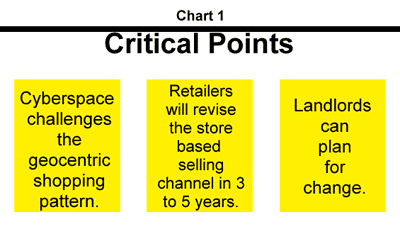
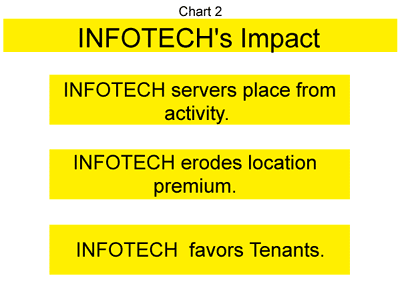
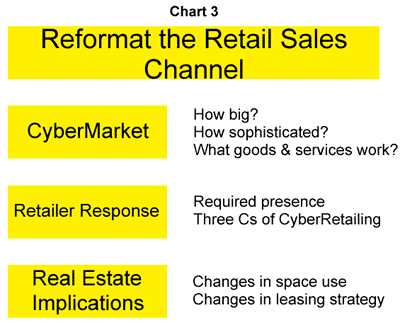

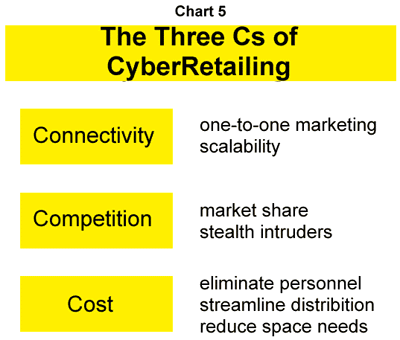
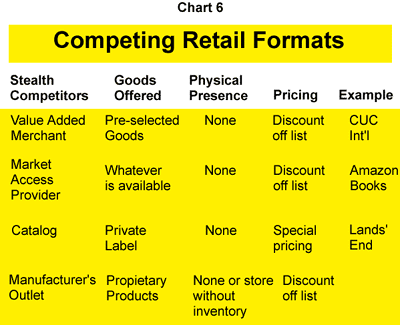
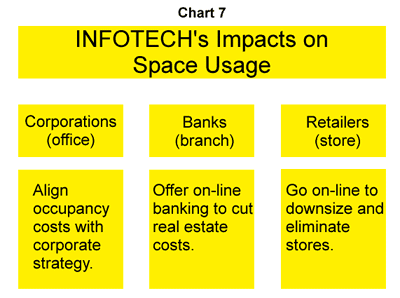
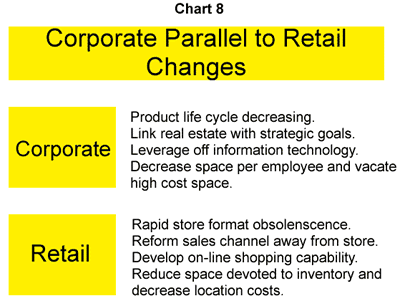
top
News Releases | Articles | Upcoming Talks | Memorable Quotes
Links | About Mark Borsuk | Search | Add to E-mail List
Contact Info | Paris Flat 4 Rent
|Home
Copyright ©1995 - 2020. Mark Borsuk. All rights reserved. Disclaimer notice |